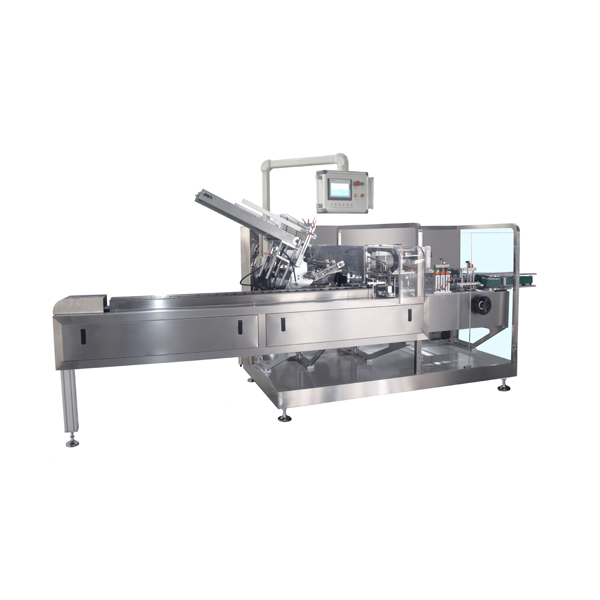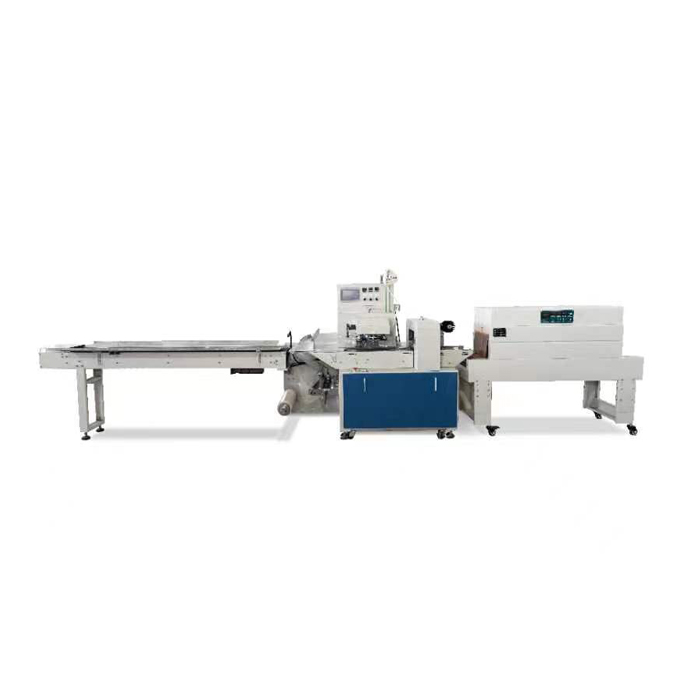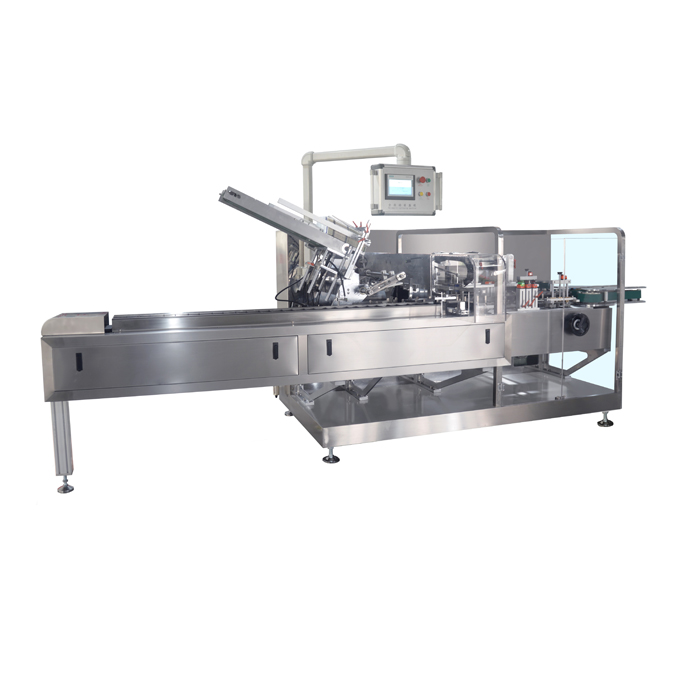Application and Development of Cartoning Machine in the Plastic Tray Food Packaging Industry

Cartoning machine in the plastic tray food packaging field are developing towards higher levels of automation, intelligence, and integration to meet market demands for efficiency, hygiene, and sustainability.
1. Current Application Status and Core Value
plastic trays (or blister packs) are common in the food industry, such as fruit and vegetable boxes, fast food boxes, and frozen food boxes. cartoning machine automatically fill these plastic tray foods into cardboard or linerboard packaging. Their core value lies in:
• Increased Efficiency and Reduced Costs: Automated packaging lines significantly improve production efficiency and reduce labor costs and workload by automatically completing pallet distribution, food filling, and sealing processes.
• Ensuring Food Hygiene and Safety: Fully automated equipment minimizes human intervention and reduces the risk of contamination. Parts of the equipment that come into contact with food are typically made of safe materials such as 304 or 316 stainless steel and have an IP65 waterproof rating, allowing for direct rinsing with water to ensure cleanliness.
• Extended Shelf Life: Some automated packaging lines integrate a vacuum gas rinsing system, which extracts air from the tray and injects protective gas before sealing, effectively inhibiting microbial growth and food oxidation, thus extending shelf life.
• Enhanced Packaging Presentation and Standardization:The machine ensures that each box of product has a uniform appearance and secure sealing, improving brand image and facilitating neat stacking in logistics and sales.
2. Technological Highlights and Development Directions
The technological development of modern plastic tray food cartoning machine mainly focuses on the following aspects:
1) High Degree of Automation and Intelligent Control
• Ordinary automated cartoning machine typically use PLCs (Programmable Logic Controllers), servo motor systems, and touch screens for control, ensuring precise movement.
• Some blister packaging machines use up to six servo motors to control forming, traction, sealing, and cutting stations respectively, achieving high-speed and high-precision production.
• Empty trays are detected using photoelectric or fiber optic sensors to avoid misoperation when there are no trays.
2) Flexible Modular and Compatible Design
• To adapt to the rapid product updates and diverse product categories in the food industry, equipment often adopts a modular design for easy adjustment and maintenance.
• The equipment can accommodate plastic trays of different sizes and shapes, such as square, round, and oval, and can handle various pallet materials.
3) The Trend Towards Integrated Production Lines
The development focus is on integrating multiple packaging processes into a single automated production line. For example, a complete production line can automatically perform pallet distribution, quantitative filling, vacuum-controlled filling, lamination and sealing, coding and labeling, and even boxing.
This integration reduces intermediate steps and manual intervention, improving overall production efficiency and hygiene safety.
4) Emphasis on Hygiene Design and Human-Machine Interaction
• Food-contact components are designed for tool-free disassembly for thorough cleaning.
Application and Development of cartoning machine in the plastic tray Food Packaging Industry
cartoning machine in the plastic tray food packaging field are developing towards higher levels of automation, intelligence, and integration to meet market demands for efficiency, hygiene, and sustainability.
1. Current Application Status and Core Value
plastic trays (or blister packs) are common in the food industry, such as fruit and vegetable boxes, fast food boxes, and frozen food boxes. Cartoning machine automatically fill these plastic tray foods into cardboard or linerboard packaging. Their core value lies in:
• Increased Efficiency and Reduced Costs: Automated packaging lines significantly improve production efficiency and reduce labor costs and workload by automatically completing pallet distribution, food filling, and sealing processes.
• Ensuring Food Hygiene and Safety: Fully automated equipment minimizes human intervention and reduces the risk of contamination. Parts of the equipment that come into contact with food are typically made of safe materials such as 304 or 316 stainless steel and have an IP65 waterproof rating, allowing for direct rinsing with water to ensure cleanliness.
• Extended Shelf Life: Some automated packaging lines integrate a vacuum gas rinsing system, which extracts air from the tray and injects protective gas before sealing, effectively inhibiting microbial growth and food oxidation, thus extending shelf life.
• Enhanced Packaging Presentation and Standardization: The machine ensures that each box of product has a uniform appearance and secure sealing, improving brand image and facilitating neat stacking in logistics and sales.
2. Technological Highlights and Development Directions
The technological development of modern plastic tray food cartoning machine mainly focuses on the following aspects:
1) High Degree of Automation and Intelligent Control
• Ordinary automated cartoning machine typically use PLCs (Programmable Logic Controllers), servo motor systems, and touch screens for control, ensuring precise movement.
• Some blister packaging machines use up to six servo motors to control forming, traction, sealing, and cutting stations respectively, achieving high-speed and high-precision production.
• Empty trays are detected using photoelectric or fiber optic sensors to avoid misoperation when there are no trays.
2) Flexible Modular and Compatible Design
• To adapt to the rapid product updates and diverse product categories in the food industry, equipment often adopts a modular design for easy adjustment and maintenance.
• The equipment can accommodate plastic trays of different sizes and shapes, such as square, round, and oval, and can handle various pallet materials.
3) The Trend Towards Integrated Production Lines
• The development focus is on integrating multiple packaging processes into a single automated production line. For example, a complete production line can automatically perform pallet distribution, quantitative filling, vacuum-controlled filling, lamination and sealing, coding and labeling, and even boxing.
• This integration reduces intermediate steps and manual intervention, improving overall production efficiency and hygiene safety.
4) Emphasis on Hygiene Design and Human-Machine Interaction
• Food-contact components are designed for tool-free disassembly for thorough cleaning.
Application and Development of cartoning machine in the plastic tray Food Packaging Industry
Cartoning machine in the plastic tray food packaging field are developing towards higher levels of automation, intelligence, and integration to meet market demands for efficiency, hygiene, and sustainability.
1. Current Application Status and Core Value
plastic trays (or blister packs) are common in the food industry, such as fruit and vegetable boxes, fast food boxes, and frozen food boxes. Cartoning machine automatically fill these plastic tray foods into cardboard or linerboard packaging. Their core value lies in:
• Increased Efficiency and Reduced Costs: Automated packaging lines significantly improve production efficiency and reduce labor costs and workload by automatically completing pallet distribution, food filling, and sealing processes.
• Ensuring Food Hygiene and Safety: Fully automated equipment minimizes human intervention and reduces the risk of contamination. Parts of the equipment that come into contact with food are typically made of safe materials such as 304 or 316 stainless steel and have an IP65 waterproof rating, allowing for direct rinsing with water to ensure cleanliness.
• Extended Shelf Life: Some automated packaging lines integrate a vacuum gas rinsing system, which extracts air from the tray and injects protective gas before sealing, effectively inhibiting microbial growth and food oxidation, thus extending shelf life.
• Enhanced Packaging Presentation and Standardization:** The machine ensures that each box of product has a uniform appearance and secure sealing, improving brand image and facilitating neat stacking in logistics and sales.
2. Technological Highlights and Development Directions
The technological development of modern plastic tray food cartoning machine mainly focuses on the following aspects:
1) High Degree of Automation and Intelligent Control
• Ordinary automated cartoning machine typically use PLCs (Programmable Logic Controllers), servo motor systems, and touch screens for control, ensuring precise movement.
• Some blister packaging machines use up to six servo motors to control forming, traction, sealing, and cutting stations respectively, achieving high-speed and high-precision production.
• Empty trays are detected using photoelectric or fiber optic sensors to avoid misoperation when there are no trays.
2) Flexible Modular and Compatible Design
• To adapt to the rapid product updates and diverse product categories in the food industry, equipment often adopts a modular design for easy adjustment and maintenance.
• The equipment can accommodate plastic trays of different sizes and shapes, such as square, round, and oval, and can handle various pallet materials.
3) The Trend Towards Integrated Production Lines
• The development focus is on integrating multiple packaging processes into a single automated production line. For example, a complete production line can automatically perform pallet distribution, quantitative filling, vacuum-controlled filling, lamination and sealing, coding and labeling, and even boxing.
• This integration reduces intermediate steps and manual intervention, improving overall production efficiency and hygiene safety.
4) Emphasis on Hygiene Design and Human-Machine Interaction
• Food-contact components are designed for tool-free disassembly for thorough cleaning.
• Multilingual touchscreens facilitate operation; some equipment supports remote PC monitoring of production status, with data searchable and downloadable for quality traceability.
2. Industry Challenges and Future Trends
The plastic tray food cartoning machine industry also faces several challenges, such as intense industry competition leading to price wars, and the need for companies to address ever-increasing challenges in product quality, safe production, and environmental protection. In the future, this sector is expected to exhibit the following trends:
• Deeper Intelligentization and Digitalization: Further integration of technologies such as the Industrial Internet, cloud computing, and big data to achieve predictive maintenance, real-time production data analysis, and end-to-end product quality traceability.
• Enhanced Flexible Production Capabilities: To adapt to the market demand for small-batch, multi-variety production, equipment needs to have rapid changeover capabilities and be able to flexibly adjust to meet the packaging requirements of different products.
• Wider Application of Environmentally Friendly Technologies: With tightening environmental policies and increased consumer environmental awareness, equipment will be more compatible with recyclable, biodegradable, or recycled packaging materials. Simultaneously, the equipment itself is also developing towards energy conservation and consumption reduction (such as reducing heating power).
3. Selection and Application Tips
When selecting a plastic tray cartoning machine for a food production line, pay close attention to the following points:
• Define your product and capacity requirements: Consider the physical properties of the food (e.g., solid particles, liquids), shape, weight, and target output to determine the machine's operating speed, precision, and functional modules.
• Assess the equipment's compatibility and flexibility: Confirm the range of pallet sizes, shapes, and materials the machine can handle, as well as the ease of adjustment when changing products.
• Focus on hygiene and safety standards and ease of cleaning: Ensure the equipment's materials and structural design comply with food industry hygiene regulations, especially for food contact parts.
• Evaluate technical support and after-sales service: Choosing a supplier that provides comprehensive technical support, spare parts supply, and operational training is crucial for ensuring stable production operation.
In summary, plastic tray food cartoning machine are helping food companies enhance their market competitiveness through technological advancements.Multilingual touchscreens facilitate operation; some equipment supports remote PC monitoring of production status, with data searchable and downloadable for quality traceability.
2. Industry Challenges and Future Trends
The plastic tray food cartoning machine industry also faces several challenges, such as intense industry competition leading to price wars, and the need for companies to address ever-increasing challenges in product quality, safe production, and environmental protection. In the future, this sector is expected to exhibit the following trends:
• Deeper Intelligentization and Digitalization: Further integration of technologies such as the Industrial Internet, cloud computing, and big data to achieve predictive maintenance, real-time production data analysis, and end-to-end product quality traceability.
• Enhanced Flexible Production Capabilities: To adapt to the market demand for small-batch, multi-variety production, equipment needs to have rapid changeover capabilities and be able to flexibly adjust to meet the packaging requirements of different products.
• Wider Application of Environmentally Friendly Technologies: With tightening environmental policies and increased consumer environmental awareness, equipment will be more compatible with recyclable, biodegradable, or recycled packaging materials. Simultaneously, the equipment itself is also developing towards energy conservation and consumption reduction (such as reducing heating power).
3. Selection and Application Tips
When selecting a plastic tray cartoning machine for a food production line, pay close attention to the following points:
• Define your product and capacity requirements: Consider the physical properties of the food (e.g., solid particles, liquids), shape, weight, and target output to determine the machine's operating speed, precision, and functional modules.
• Assess the equipment's compatibility and flexibility: Confirm the range of pallet sizes, shapes, and materials the machine can handle, as well as the ease of adjustment when changing products.
• Focus on hygiene and safety standards and ease of cleaning: Ensure the equipment's materials and structural design comply with food industry hygiene regulations, especially for food contact parts.
• Evaluate technical support and after-sales service: Choosing a supplier that provides comprehensive technical support, spare parts supply, and operational training is crucial for ensuring stable production operation.
In summary, plastic tray food cartoning machine are helping food companies enhance their market competitiveness through technological advancements.Multilingual touchscreens facilitate operation; some equipment supports remote PC monitoring of production status, with data searchable and downloadable for quality traceability.
2. Industry Challenges and Future Trends
The plastic tray food cartoning machine industry also faces several challenges, such as intense industry competition leading to price wars, and the need for companies to address ever-increasing challenges in product quality, safe production, and environmental protection. In the future, this sector is expected to exhibit the following trends:
• Deeper Intelligentization and Digitalization: Further integration of technologies such as the Industrial Internet, cloud computing, and big data to achieve predictive maintenance, real-time production data analysis, and end-to-end product quality traceability.
• Enhanced Flexible Production Capabilities: To adapt to the market demand for small-batch, multi-variety production, equipment needs to have rapid changeover capabilities and be able to flexibly adjust to meet the packaging requirements of different products.
• Wider Application of Environmentally Friendly Technologies: With tightening environmental policies and increased consumer environmental awareness, equipment will be more compatible with recyclable, biodegradable, or recycled packaging materials. Simultaneously, the equipment itself is also developing towards energy conservation and consumption reduction (such as reducing heating power).
3. Selection and Application Tips
When selecting a plastic tray cartoning machine for a food production line, pay close attention to the following points:
• Define your product and capacity requirements: Consider the physical properties of the food (e.g., solid particles, liquids), shape, weight, and target output to determine the machine's operating speed, precision, and functional modules.
• Assess the equipment's compatibility and flexibility: Confirm the range of pallet sizes, shapes, and materials the machine can handle, as well as the ease of adjustment when changing products.
• Focus on hygiene and safety standards and ease of cleaning: Ensure the equipment's materials and structural design comply with food industry hygiene regulations, especially for food contact parts.
• Evaluate technical support and after-sales service: Choosing a supplier that provides comprehensive technical support, spare parts supply, and operational training is crucial for ensuring stable production operation.
In summary, plastic tray food cartoning machine are helping food companies enhance their market competitiveness through technological advancements.


